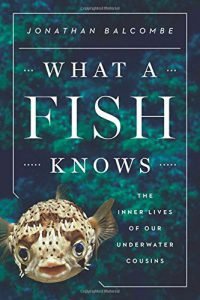What a fish knows, perceives, feels…
The North American ethologist Jonathan Balcombe is well-known to a broader public by his bestseller “Pleasurable Kingdom”1. His latest book “What a Fish Knows”2 published in 2016 does not take second place. On 250 pages the author comes across all kinds of fish species and shows us the unbelievable diversity of abilities to see, hear, smell, and sense, to the point of amazing cognitive performances of our “underwater-cousins”.
In his “Pleasurable Kingdom” Balcombe demonstrated courage as an acknowledged scientist to gather plenty of anecdotal observations of animal behaviour while anecdotes are frowned upon as “non-scientific” usually. In “What a Fish Knows”, too, the author describes many anecdotal observations of fish behaviour he has been told. But here he clearly distincts between “scientific findings”, that is to say results e.g. from experiments that can be reproduced by other scientists, and “pre-scientific”, i.e. not reproduced observations. In my view it belongs to the major strengths of the book that it draws the distinction between the two levels of perception clearly, but without valuing one or the other. And quite rightly, because if science were insulated from accidental observations, how would scientists come up with the idea of testing any hypothesis? This may apply all the more for a young and widely ramified science as the one on the behaviour of fishes, of far more than 30.000 species to be clear.
At the beginning, Balcombe takes us on a short trip across his own biography with fishes, from the schoolboy who has been taken along for fishing and participated in it to his studies in biology and ethology to the germination of the idea that fishes are beings like us. He plunged the world of fishes for five years in order to write his new book. He describes the different senses, also the lateral line which we can understand but theoretically as we do not dispose on something similar, and he shows how the specific development of a particular sense in one species is linked up to the ecological niche that this species has been able to secure in the course of evolution.
Thus, an incredible diversity of specific worlds of perception becomes apparent while reading onward. Sometimes you find yourself spontaneously wondering: How does this work in my case? How do I perceive this or that – and how much is kept hidden from me because I lack the in-depth sensibility for it? Balcombe’s book is not only a wonderful introduction to the life of fishes, beyond that it is an invitation to contemplate in amazement on life per se and on its many forms. It can only wish that this book will find many readers who lay it aside only after having reached its last page and who then perceive the world with more respect and love.
For the time being, Balcombe’s new book is available in English only. Translations into Chinese, Japanese, and Korean are in progress, whereas the reviewer is currently searching for a German publisher. However the book is written in such a fascinating and easy to read way that speakers of a different native language who are trained in English should not miss this enjoyment of reading.
Billo Heinzpeter Studer
